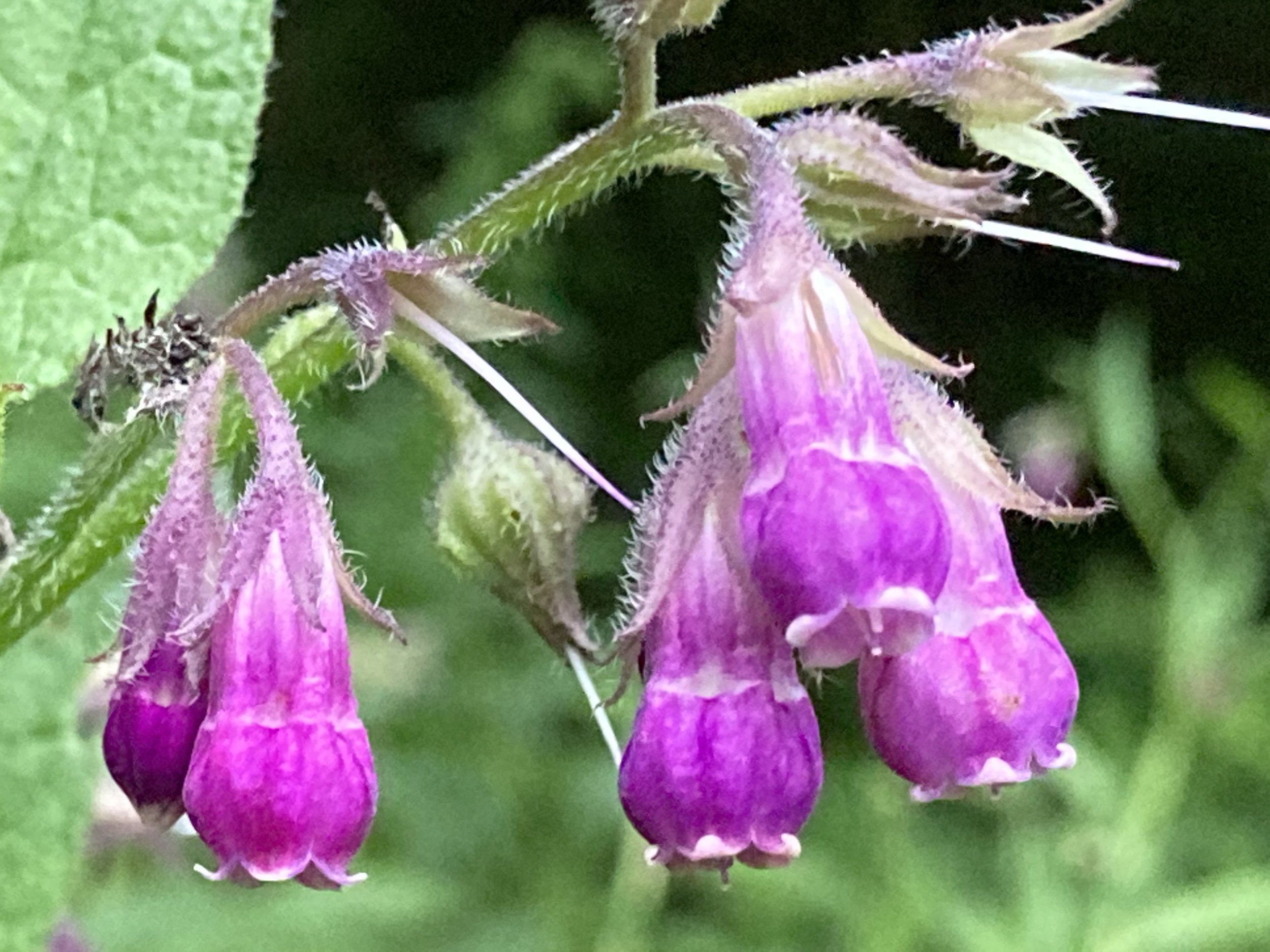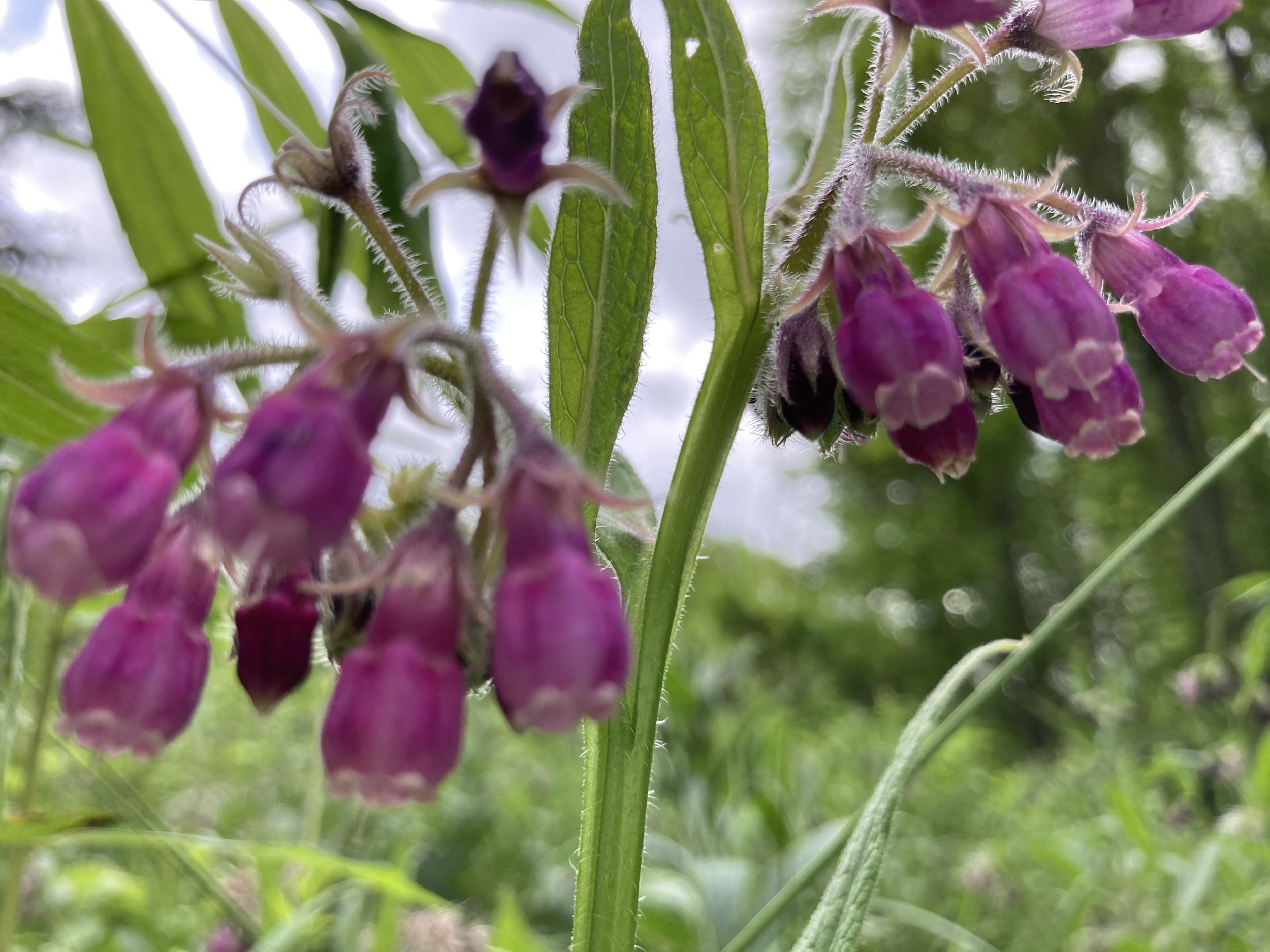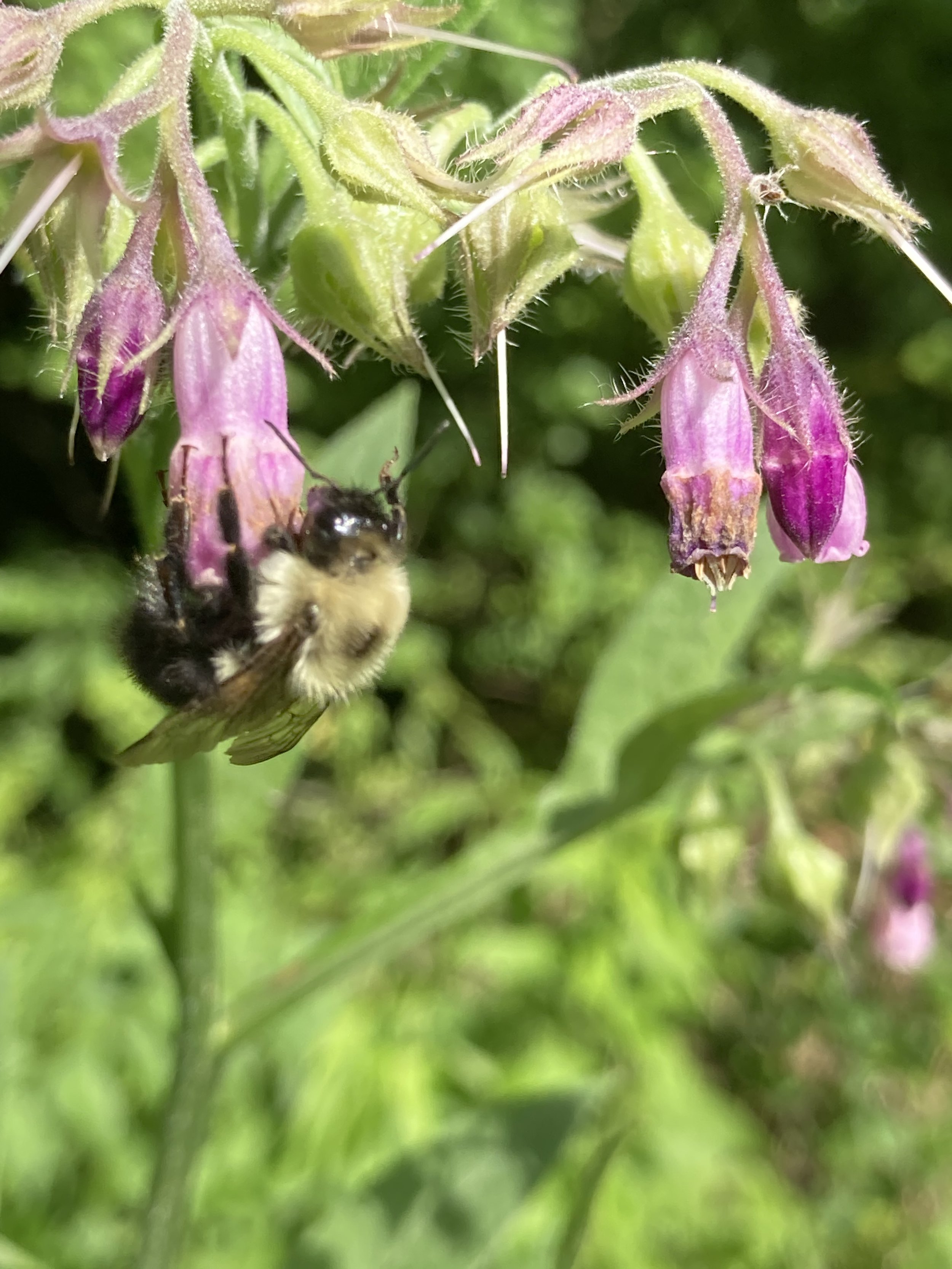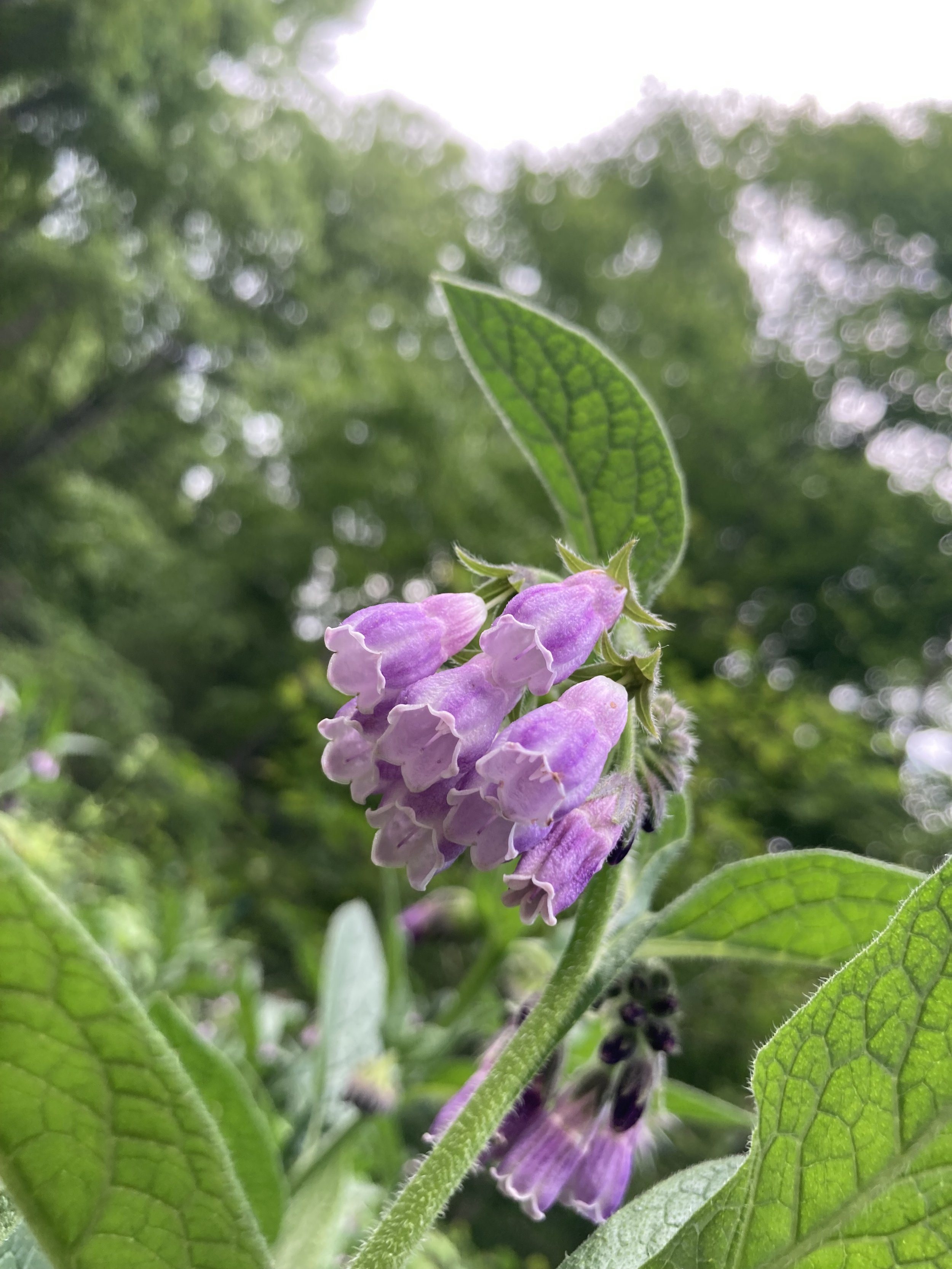Comfrey Bocking 14~Beyond organic~1 Crown Bare Root Plant
Comfrey,Bocking 14 (Symphytum uplandicum)
~1 crown, 2 yr + bare root plant~ Plants will vary in shape and size but will be around the same age as the plant in the photo with 4" root length at least~
Our comfrey is grown using beyond organic gardening methods. This particular comfrey may be propagated easily via root and crown cutting. Bocking 14 is a sterile hybrid, however seeds may still be produced but not many. (Even the true comfrey, which produces seed does not spread aggressively via seed like other plants.)~This is one of the first plants to flower in the early spring and therefore a pollinator magnet for your native bee population!
Comfrey is a versatile plant helper in your organic perennial garden: Use it for:
~Soil amending (breaks up clay soil and retrieves valuable nutrients from the soil with its deep penetrating roots)
~Green Manure~(make compost tea by soaking leaves in water for 3-7 days and use on your plants as fertilizer)
Another method is to grow comfrey as a companion perennial with other nitrogen/potassium loving plants. Fruit trees
are one example, and it also assists in strengthening the trees immune system. If you are purchasing new land and unsure
on what sort of chemical soup was used, you can plant an entire field of comfrey to begin
ammending and healing the soil prior to planting food~
~Animal Fodder~
~Beneficial insect attractant~
~The List goes on!~
~Much is written on the medicinal qualities of comfrey, but I highly suggest doing your own research
on the benefits versus the contraindications...Topically it can be used for healing wounds and bone rebuilding using
it as a poultice or a salve~
Planting Care:
Create a small comfrey bed or start planting around your fruit trees, about 1-2ft distance from the base of the tree.
Dig a hole twice the size as the entire crown cutting, place cutting with leaves upright,roots down and fill in with soil around base of crown. Make sure to water frequently with new plants.
You do not need to add fertilizer. You can even plant it in clay like soils as long as the soil is not contaminated with soil pollutants.
Leaves may be cut and harvested several times during spring/summer/fall.
Crown cuttings will produce flowers first year of planting as they are at least 2 years old.
Comfrey,Bocking 14 (Symphytum uplandicum)
~1 crown, 2 yr + bare root plant~ Plants will vary in shape and size but will be around the same age as the plant in the photo with 4" root length at least~
Our comfrey is grown using beyond organic gardening methods. This particular comfrey may be propagated easily via root and crown cutting. Bocking 14 is a sterile hybrid, however seeds may still be produced but not many. (Even the true comfrey, which produces seed does not spread aggressively via seed like other plants.)~This is one of the first plants to flower in the early spring and therefore a pollinator magnet for your native bee population!
Comfrey is a versatile plant helper in your organic perennial garden: Use it for:
~Soil amending (breaks up clay soil and retrieves valuable nutrients from the soil with its deep penetrating roots)
~Green Manure~(make compost tea by soaking leaves in water for 3-7 days and use on your plants as fertilizer)
Another method is to grow comfrey as a companion perennial with other nitrogen/potassium loving plants. Fruit trees
are one example, and it also assists in strengthening the trees immune system. If you are purchasing new land and unsure
on what sort of chemical soup was used, you can plant an entire field of comfrey to begin
ammending and healing the soil prior to planting food~
~Animal Fodder~
~Beneficial insect attractant~
~The List goes on!~
~Much is written on the medicinal qualities of comfrey, but I highly suggest doing your own research
on the benefits versus the contraindications...Topically it can be used for healing wounds and bone rebuilding using
it as a poultice or a salve~
Planting Care:
Create a small comfrey bed or start planting around your fruit trees, about 1-2ft distance from the base of the tree.
Dig a hole twice the size as the entire crown cutting, place cutting with leaves upright,roots down and fill in with soil around base of crown. Make sure to water frequently with new plants.
You do not need to add fertilizer. You can even plant it in clay like soils as long as the soil is not contaminated with soil pollutants.
Leaves may be cut and harvested several times during spring/summer/fall.
Crown cuttings will produce flowers first year of planting as they are at least 2 years old.
Comfrey,Bocking 14 (Symphytum uplandicum)
~1 crown, 2 yr + bare root plant~ Plants will vary in shape and size but will be around the same age as the plant in the photo with 4" root length at least~
Our comfrey is grown using beyond organic gardening methods. This particular comfrey may be propagated easily via root and crown cutting. Bocking 14 is a sterile hybrid, however seeds may still be produced but not many. (Even the true comfrey, which produces seed does not spread aggressively via seed like other plants.)~This is one of the first plants to flower in the early spring and therefore a pollinator magnet for your native bee population!
Comfrey is a versatile plant helper in your organic perennial garden: Use it for:
~Soil amending (breaks up clay soil and retrieves valuable nutrients from the soil with its deep penetrating roots)
~Green Manure~(make compost tea by soaking leaves in water for 3-7 days and use on your plants as fertilizer)
Another method is to grow comfrey as a companion perennial with other nitrogen/potassium loving plants. Fruit trees
are one example, and it also assists in strengthening the trees immune system. If you are purchasing new land and unsure
on what sort of chemical soup was used, you can plant an entire field of comfrey to begin
ammending and healing the soil prior to planting food~
~Animal Fodder~
~Beneficial insect attractant~
~The List goes on!~
~Much is written on the medicinal qualities of comfrey, but I highly suggest doing your own research
on the benefits versus the contraindications...Topically it can be used for healing wounds and bone rebuilding using
it as a poultice or a salve~
Planting Care:
Create a small comfrey bed or start planting around your fruit trees, about 1-2ft distance from the base of the tree.
Dig a hole twice the size as the entire crown cutting, place cutting with leaves upright,roots down and fill in with soil around base of crown. Make sure to water frequently with new plants.
You do not need to add fertilizer. You can even plant it in clay like soils as long as the soil is not contaminated with soil pollutants.
Leaves may be cut and harvested several times during spring/summer/fall.
Crown cuttings will produce flowers first year of planting as they are at least 2 years old.




